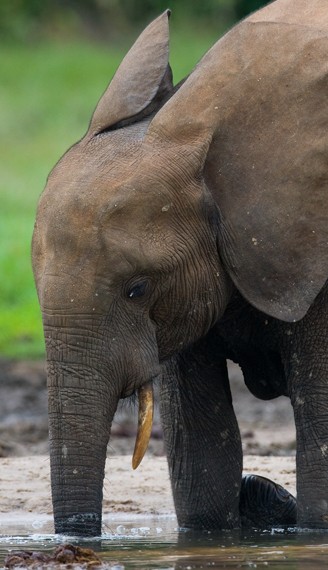African Forest Elephant
As the name suggests, the African Forest Elephant is a forest dwelling creature that is mainly found roaming the forests of Western and Central Africa. Out of the three major species of elephants found in Africa and Asia, the African Forest Elephant is the smallest and the third largest land animal of the world.
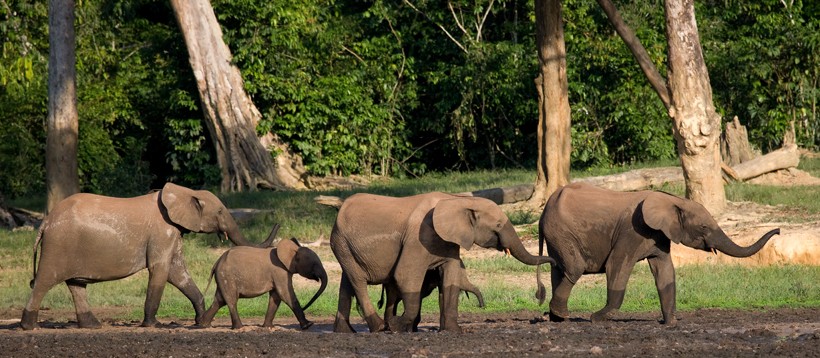
Group african forest elephants walking in congo, africa
?
Image credits: GUDKOV ANDREY/Shutterstock
Earlier, both the African Forest Elephant and African Bush Elephant were considered as animals of same species and were simply known as African Elephants. However, recent genetic studies revealed that these elephants do not fall anywhere close to each other to be regarded as same species. They are simply distant relatives. As a result, the African Elephants were duly named as African Forest Elephant and African Bush Elephant based on their preference of habitat.
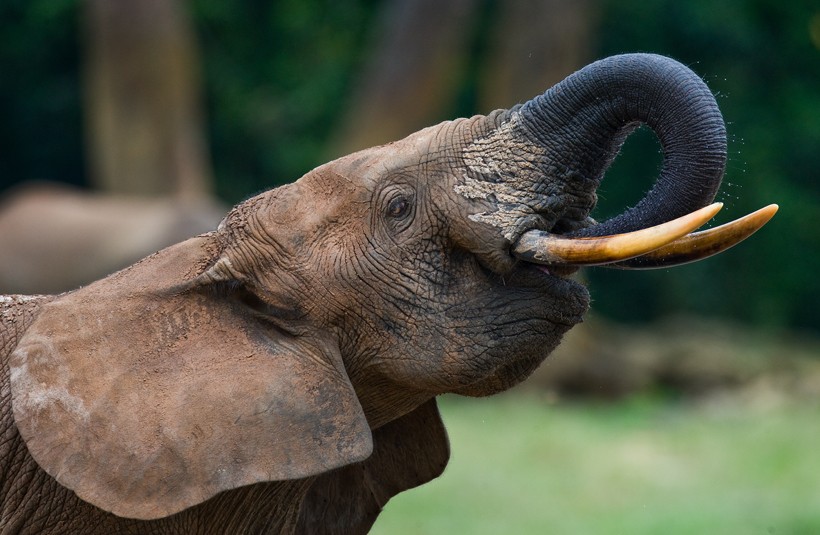
African forest elephant drinking
?
Image credits: GUDKOV ANDREY/Shutterstock
These forest elephants are smaller as well as darker compared to the bush elephants. The ears of this species are also smaller and have a rounder appearance. Moreover, the forest elephant has the longest and narrowest mandible of all elephant species. The male African Forest Elephant can reach a height of 2.5 meters (8 ft) whereas the average height of females is 2 meter (6.6 ft). However, unlike its relatives that display curvy tusks, the tusks of African Forest Elephants are straight and long in order to help the animal move conveniently through the dense undergrowth of its habitat.
African Forest Elephant vs African Bush Elephant
African Forest Elephant and African Bush Elephant are different species that belong to the same genus Loxodonta. As both species are found in Africa and displaying only a slight physical difference, the African Forest Elephant was classified as a subspecies of African Bush Elephant earlier. The earlier scientific name of this forest elephant was Loxodonta africana cyclotis. However, recent DNA tests (2010) proved otherwise and showed that these two species have more genetic diversity than previously believed, which finally led to the reclassification of the African Forest Elephant as a separate species of the genera Loxodonta. Therefore, it was renamed as Loxodonta cyclotis.
Besides the genetic diversity, the African Forest elephant has a number of physical differences compared to the African Bush elephant, also known as the Savanna elephant. Apart from having a darker coloration and smaller, rounder ears, the African Forest Elephant can be identified easily from its Savanna relative by their smaller size and straighter tusks. Unlike the Savanna Elephants, the tusks of African Forest Elephants are longer and displays a light yellowish or pinkish tinge. In fact, a bull of this species has been found to have extraordinarily long tusks that almost touched the ground. Moreover, similar to Asian Elephants and contrary to African Bush Elephants, the forest elephants have five toenails on their forefoot and just four on their hind foot.
Assumed subspecies
After a DNA test (2003), is was concluded that the African pygmy elephant (described as Loxodonta pumillio or Loxodonta fransseni) is a monophyletic group from forest elephants (L. cyclotis). This DNA study was, however, not completely unambiguous.
The Pygmy Elephants are found mainly in the Congo Basin. Additional studies claim that the diminutive size and early maturity of Pygmy Elephants is a result of adapting to the surrounding environment and therefore these elephants are simply a subspecies of African Forest Elephants.
The Borneo Elephant (Elephas maximus borneesis) is also referred to as Pygmy Elephant but belongs to a completely other Elephas genus (containing all Asian Elephants).
Anatomy and Characteristics
Being a smaller relative of Savanna Elephants, the average shoulder height of African Forest Elephant is 216 cm. Studies regarding the measurement of forest elephants found that these animals stop growing after about 12 years of age which is a few years younger than their Savanna relatives. Besides, they also have a lower growth rate than the African Bush Elephants.

The tusks of the forest elephants are straight and exude a yellowish or a pinkish tinge.
?
Image credits: GUDKOV ANDREY/Shutterstock
The tusks of these elephants are thinner, straighter and oriented more vertically in order to assist these giants to pass through the dense forest efficiently. These tusks can grow as long as 1.5 meters and weight between 50 – 100 pounds.
The ears of these animals are also rounder and smaller in comparison with the African Bush Elephants that possess the largest ears of all species of elephants found in the world. Moreover, these two elephant species show also prominent differences in their skull morphology.
Habitat
African Forest Elephants are found in large numbers in the forests of Western and Central Africa. Their habitats mostly involve the lowland tropical rainforests, roughly evergreen or deciduous rainforests and various swamps. However, elephants keep changing their habitat depending on the season.
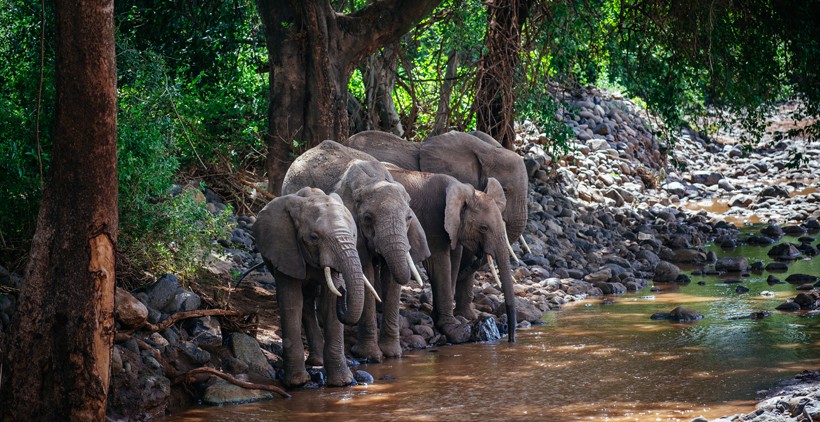
African forest elephants in their natural habitat in Congo, Africa
?
Image credits: costas anton dumitrescu/Shutterstock
The African Forest Elephants have been seen to move into the swampy areas during dry seasons whereas they inhabit the lowland forest areas during wet seasons. Moreover, due to the large-scale illegal hunting of elephants for their tusks and persecution by the local human population, these elephants are beginning to spend more time within the dense rainforest as a way of taking refuge. Besides the hunting, the loss of habitat caused by deforestation has become also a major threat to the survival of these giant mammals.
Diet and Predation
Diet
The diet of African Forest Elephants mainly consists of leaves, barks, fruits and twigs of different rainforest trees along with occasional mineral licks. Fruits make up a high proportion of this diet with Swartzia fistuloides, Duboscia macrocarpa and Klainedoxa gabonensis being the primary preferences. The tree species that are eaten by these elephants in large proportions are mostly legumes like Petersianthus macrocarpus, Pentaclethra eetveldeana and Piptadeniastrum africanum. However, their diet might change depending on the availability of trees and fruits around their habitat. Regarding the mineral requirement, these herbivorous forest elephants supplement it by eating soil.

African forest elephant crossing a river
?
Image credits: Grodza/Shutterstock
As elephants defecate half-digested food and also covers long range distances every day in search of food and water, they play a primary role in dispersing the seeds of many species of trees and plants and which earned them the name of Forest Gardeners. In fact, for certain tree species like the Omphalocarpum spp. and Balanites wilsoniana, the African Forest Elephants are the only seed disperser. In Afro-tropical forests, a large number of plant species are disseminated by these forest elephants at very long distance which play a vital role in the dynamics of the population of certain species of plants and forest trees. Moreover, it has been found that many seeds of trees and plants germinate at a very fast rate after passing through the gut of an elephant.
Predation
Due to their large size and heavy bodies, an adult African Forest Elephant hardly gets predated by other animals. However, newborns of this species that gets separated from the herd or are left alone briefly might get predated by large carnivores like lions and hyenas that share the same habitat.
Besides animals, humans are the major predator of these majestic creatures. Every year, a large number of African Forest Elephants get killed by poachers because of the increasing demand for ivory. Apart from poachers, elephants also get killed by farmers who view them as a nuisance for their crops as elephants tend to forage in the crop cultivation areas that are too close to their habitat. As a result of this excessive hunting, a majority of African Forest Elephants have developed the habit of traveling and feeding during the night.
Reproduction and Life Cycle
The African Forest Elephants exhibit a polygamous sexual behavior. Males often compete with each other to mate with estrous females due to which the stronger, larger and dominant male get the chance to mate with a number of females. Like other species of elephants, the males of African Forest Elephants also experience ‘musth’ which is a hormonal state characterized by an increasingly aggressive behavior. The males experiencing musth can be identified by a special fluid secreted by their temporal gland located in between their eye and ear. Generally, musth can occur among males between the age of 15 and 25 years. There is a correlation between the period of musth and age of elephants. It occurs among younger males for a short period while the older males tend to experience it for longer periods. Musth occurs during dry season among younger males while older males go through it during the wet season which is also the time when a large number of female elephants go into estrous.
Moreover, the male elephants exhibit peculiar behavior during this hormonal state. The males experiencing musth walk in a more erect manner by holding their head high and tucking their long tusks inward. They also frequently wave their ears in order to spread their musth smell towards the females and transmit a low-frequency call known as musth rumble. This rumble, which can be lower than 14Hz, is performed mostly by the younger males and is responded by female elephants with a characteristic call. Besides, an elephant in musth also dribbles its urine slowly for getting it sprayed all over their hind legs so that an estrous female can easily spot them. On the other hand, an estrous female also displays certain behavior that attracts a male going through musth. The estrous cycle among female elephants occurs every 15 weeks and doesn’t last more than 2 days.
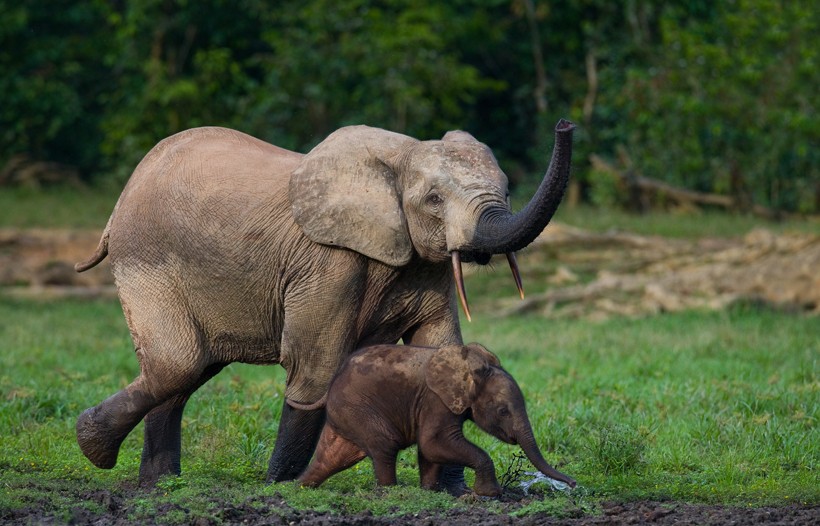
African forest elephant with cub
?
Image credits: GUDKOV ANDREY/Shutterstock
Female African Forest Elephants become sexually mature between 8 and 12 years of age. Males pass their puberty a year or two later at the age of 10-14. However, their age of attaining sexual maturity also depends on the available nutrition and population density. Females usually conceive after mating two or three times and give birth to a single calf after a gestation period that can last up to 22 months. Even though the uterus of a female elephant possess plenty of room to gestate twins, the conception of twins is extremely rare. The calf is nursed by its mother for about six and a half year and it starts to take solid food at the age of one.
A newborn calf always stays in close proximity with its mother and hardly moves beyond the distance of 5 meters from the mother elephant. A calf of the African Forest Elephant is able to stand on its feet shortly after birth and soon begins to follow the mother’s herd. It has also been observed that other female elephants of the herd support the mother in taking care of the calf.
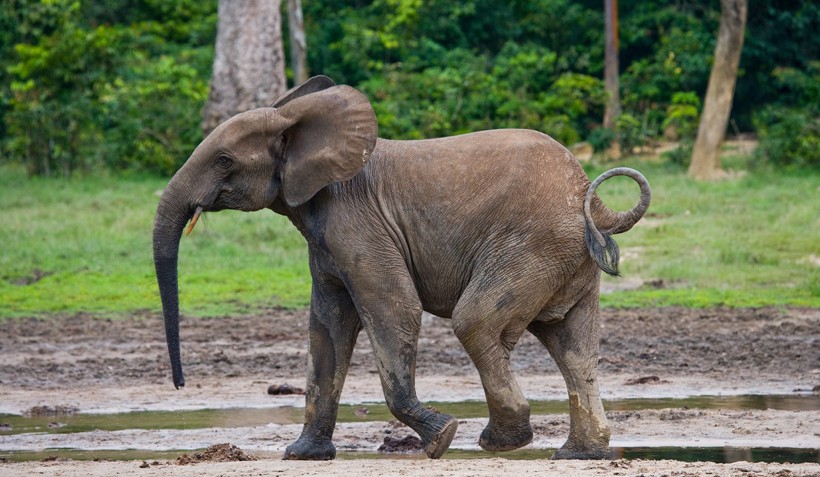
After reaching sexual maturity, the male offspring disperse to lead a solitary life.
?
Image credits: GUDKOV ANDREY/Shutterstock
The male calves stay with the herd until they hit puberty while females might stay with their mother’s herd for the rest of their life. However, depending on the availability of food and mating opportunities, the female calves might join other herds after attaining maturity. During the time the calves spend their time with their mother, they learn the various techniques of navigating through their complex environment for finding food and water.
Behavior, Communication and Intelligence
Unlike other species of elephants that travel in large groups, the African Forest Elephant generally forms smaller groups. A typical herd of this species may consist of a maximum of 8 and a minimum of two individuals. The average number of individuals in a group is five which mostly consist of female relatives. Most of the herds are formed by a mother along with her offspring or a few females and their offspring. After reaching sexual maturity, the female offspring usually stay with the herd while the male offspring disperse to lead a solitary life. Unlike the African Bush Elephant, these forest elephants do not interact or mingle with other herds.
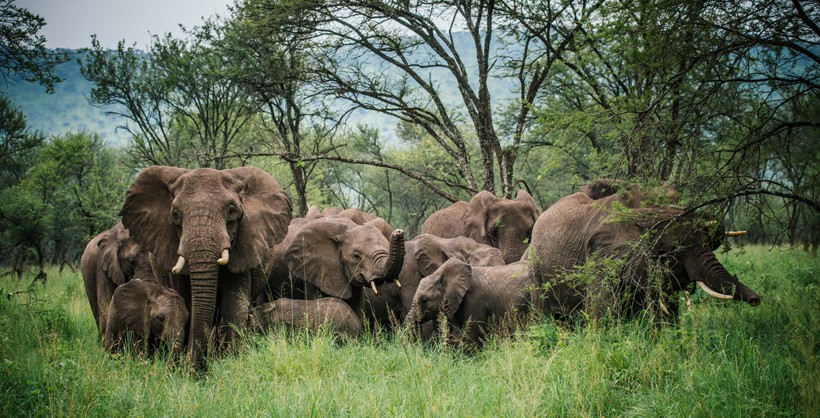
African forest elephant group in the african forest, congo basin
?
Image credits: costas anton dumitrescu/Shutterstock
Similar to other elephants, the African Forest Elephants communicate with other elephants foraging in a wide range through emitting low-frequency sounds that can be as low as 5 Hz. As the habitat of these animals mostly includes dense forests, there is very little information regarding their exact way of communication and perception. The range of detecting calls among the African Forest Elephants is shorter compared to Savanna Elephants that detect the calls of their herd over a very long distance. Besides their acute sense of hearing, these herbivorous mammals also possess a keen sense of smell. Their ability to detect very low vibration coming through the ground helps them to locate sources of water and their strong sense of smell makes it convenient for detecting food sources.

The trunk provide them with very sensitive tactile perception ability
?
Image credits: GUDKOV ANDREY/Shutterstock
These elephants have good vision and their skin and trunk provide them with very sensitive tactile perception ability. They use their long and flexible trunk to gather information about different objects. After touching an unknown object with their trunk, they insert the trunk into their mouth in order to perceive the composition of the object.
Population and Conservation
African Forest Elephants are spread all across the forested areas of Western and Central Africa. They are found mainly in northern Congo and the south-western parts of Central African Republic. A small population of forest elephants can also be spotted in Southern Ghana, the South-eastern coast of Gabon and in Cote D’Ivoire.
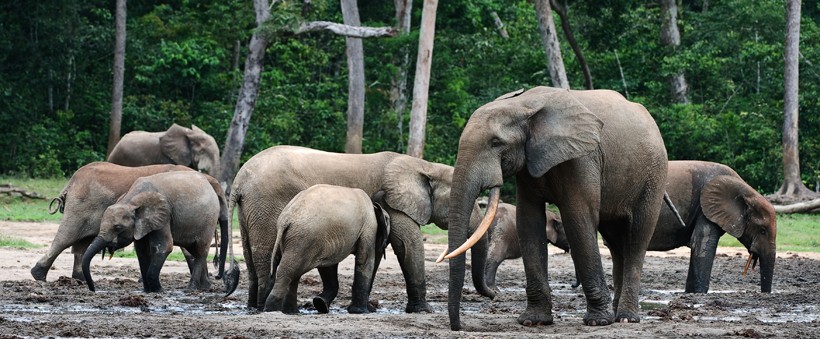
African forest elephant group in the mud
?
Image credits: Sergey Uryadnikov/Shutterstock
The population of African Forest Elephant is threatened by a number of factors ranging from poaching to loss of habitat to climate change. It has been estimated that in an earlier time, at the beginning of 20th century, more than 700,000 African Forest Elephants roamed the tropical rainforests of Africa. Due to the increasing demand for ivory, the numbers have drastically fallen to less than 100,000. As a result, these heavyset animals have been listed under the category of Vulnerable Species by the IUCN because of their fast declining numbers which can lead them to extinction in a short time. However, with the implementation of a worldwide ban on killing elephants for ivory, the number of elephants poached per year has decreased to some extent. Unfortunately, the illegal poaching still continues in many parts of Africa making these animals prone to extinction.
Evolutionary History
The African Forest Elephant, along with its distant Savanna relative, is said to have evolved from one common ancestor which is believed to be the Woolly Mammoth. Genetic studies confirmed that these two elephant species split from each other and started evolving separately about 2 – 7 million years ago. As a result, both African Forest and African Bush Elephants show significant morphological and genetic differences.
Funfacts
- The African Forest Elephant is the smallest of all the three major species of elephants.
- Likewise, the herds of African Forest Elephants contain the lowest number of individuals (2-8).
- African Forest Elephants are the primary dispersers of seeds for many trees and plant species and therefore they are often referred to as Forest Gardeners.
- The tusks of the forest elephants are straight and exude a yellowish or a pinkish tinge.
- African Forest Elephants get killed in large numbers by humans because of their long straight tusks.
